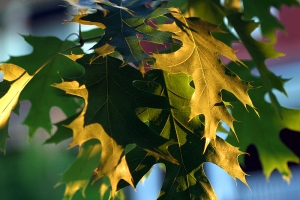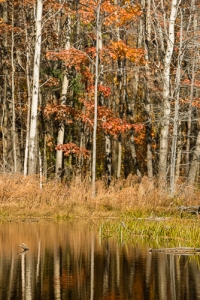Quercus - The Oaks
Quercus is a large genus of woody plants from the Northern Hemisphere, including up to 400 species of what are commonly known as ‘oaks’. In North America the oaks fall almost exclusively into one of two groups, the red oak group with bristles at the lobe tips and acorns maturing over two years; and the white oak group, with lobe tips lacking bristles and acorns maturing in one year. Oaks can be evergreen or deciduous. The evergreens come from warm and arid regions and their leaves are thick and leathery as an adaptation for drought. Most of the evergreen species also have prickles which are a defense against herbivory, and are especially important for evergreens because their leaves are that much more conspicuous to herbivores when other plants have lost all their foliage. Almost all oaks are trees, but in drier areas with shallow or poor soil, shrub oaks emerge from the rich gene pool that is Quercus. Aridity and poor soils tend to coax adaptation and expression, which can lead to isolation---three keys to speciation.
ETYMOLOGY
HYBRIDIZATION
Botanists and naturalists often point out that oaks hybridize promiscuously. Within their respective groups (red and white), the oaks frequently spawn cryptic offspring with leaves not fitting neatly into a known species, and in many cases, with leaves representative of more than one species found on the same tree. Confused, frustrated, or accommodating plant people usually settle for referring hybrid oaks to a group that could safely include them. Other characters used to identify oaks are buds, bark, acorn cups or caps, and, to some degree, habitat.
HABITATS
Oaks inhabit most terrestrial environments within their range — wetlands, prairies, grasslands, uplands, woodlands, the coastal zone, mountain forest, outcrops, and fertile bottomlands. The genus offers a classic view of species diversity over a wide range of habitat types. Consider other genera—some exhibit a similar pattern of exploiting nearly every habitat type in their range (for example Carya (hickories)) while others are faithful to a single habitat and have not evolved species to colonize those other habitats (for example Platanus (sycamore)).
PROPAGATION
SPECIES EASILY SEEN HERE
Quercus rubra, northern red oak---Stately, large upland oak sometimes straying into moist lowland soils with good drainage, but most commonly found in rich or mesic woods. Keep in mind upland doesn’t have to mean dry, but rather suggests off the valley floors and out of the bottomlands where moisture collects. Some upland woods harbor very moist soils and, consequently, moisture-loving plants. The bark of Quercus rubra is deeply furrowed or fissured with rosy highlights.
Quercus velutina, black oak---Another large and stately upland oak that may be considered a little more coarse than Q. rubra, this species can grow as tall as the other upland oak species. It’s also common in woods where soil is coarse and well drained but can be found on fairly rich sites. Leaves are as variable as any of the oaks we see in the east, ranging in breadth, length, depth of lobes and even thickness. Quercus velutina is commonly suggested as a parent in hybrid oaks.
Quercus coccinea, scarlet oak---This species exhibits stricter fidelity to sandy or rocky sharply drained soils than the first two. Scarlet oak is found on gorge rims, in rock, on outcrops and in areas that have burned or are fire-prone. An often distinguishing leaf character is the deeply rounded inter-lobe in the lower half of the leaf. Sometimes our understanding of a species increases when we see it in another habitat that’s scarce in our area. This oak is a good example, being abundant in the New Jersey pine barrens where sandy soils dominate. Knowing that habitat helps to understand why scarlet oak occurs where it does in our area. A good place to see scarlet oak is at South Hill.
Quercus montana, chestnut oak---This prince of an oak grows in upland woods, on gorge rims, and on lake cliffs. With maturity the bark forms furrows so deep and blocky as to suggest cork oak (Quercus suber of the Mediterranean region). Chestnut oak also has long and blunt-lobed leaves similar to the swamp white oak (see below). A good place to see chestnut oak is at Thatcher’s Pinnacles.
Quercus alba, white oak---One of America’s classic trees because the canopy takes a rounded form as it ages, with branches sometimes reaching the ground. The bark of white oak is flaky-shreddy in middle age but sometimes with the oldest trees, you have to look pretty high up into the canopy to find this character. Found in upland woods or more open upland woodlands. Somewhat of a generalist but Wiegand and Eames (1926) suggest it is more tolerant of clay than most oaks.
Quercus bicolor, swamp white oak---A wetland oak to complement our more common upland species. Swamp white oak will grow in soils that are saturated for extended periods of time and will not be found upland, especially the higher and drier you go. Further south, in the mid-Atlantic states, there is a much greater diversity of wetland oak species--pin oak, water oak, willow oak, etc. Here in the northeast and in the Finger Lakes in particular, Quercus bicolor is our main wetland species. South Hill is a good place to see swamp white oak.
References cited:
- Britton, N.L. and A. Brown. 1970. An Illustrated Flora of The Northern United States and Canada. A republication of the 2nd revised ed. as published by Charles Scribner’s Sons in 1913 under the title An Illustrated Flora of the Northern United States, Canada, and the British Possessions. Dover Publications, New York, NY, USA.
- Wiegand, K. and A. Eames. 1926. The Flora of The Cayuga Lake Basin. Cornell University, Ithaca, New York, USA.
About
By Dan Segal
Photos by Dan Segal, Tom Murphy VII, Paul S. Schmitt





